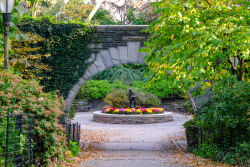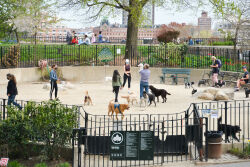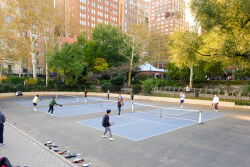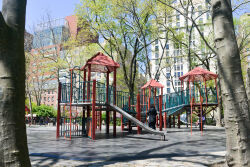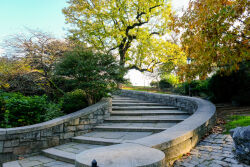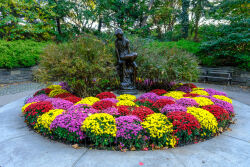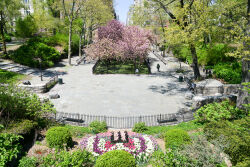Carl Schurz Park
Gracie Mansion
Gracie Mansion stands in Carl Schurz Park above Hell Gate, a roaring stretch of water where the Harlem River, East River, and Long Island Sound meet. This 18th century house is now the official residence of the Mayor of New York City.
The Dutch West India Company deeded 106 acres of northern Manhattan land in 1646 to Sybout Claessan, who dubbed the jutting riverbank “Horn’s Hook” in honor of his native village of Hoorn in Holland. The first house on the site was built around 1770 by Jacob Walton, a wealthy Flatbush merchant and British Loyalist. Walton not only built a substantial home for himself and his wife, Polly Cruger, but he also built a secret escape tunnel from the house to the East River shore.
At the start of the American Revolution, George Washington realized the strategic importance of Horn’s Hook and seized the Walton property. The American troops built a fort on the Walton lawn and set up a series of cannons facing the East River. The British regiment stationed across the river bombarded the fort on September 8, 1776, destroying the ramparts and the Walton residence.
The Walton heirs reclaimed the property in 1798 and sold the land for $5,625 to Scottish shipping magnate Archibald Gracie (1755-1829). Gracie, who emigrated from Scotland in 1784, was one of the wealthiest men in the city. He built this two-story mansion in 1799, and it served as the Gracie family’s country residence, situated among similar houses owned by such families as the Astors and the Schermerhorns. Gracie often held elegant parties for his neighbors and an exclusive circle of friends that included Louis Phillipe (later King of France), President John Quincy Adams, Alexander Hamilton, James Fenimore Cooper, and Washington Irving. Gracie incurred substantial debts due to shipping embargoes and unpaid claims during the War of 1812, however, and by 1819 he was forced to dissolve his business practices and sell his property. The Foulke and Wheaton families owned this mansion for the 60 years following Gracie’s demise, a period that saw nearby farmland yield to brownstones and tenements.
The City acquired this property by condemnation in 1891 for park purposes. The 11 acres of the former Gracie Estate became the core of the new East End Park, which stretched along the East River from 84th Street to 90th Street. This park was later named for Carl Schurz (1829-1906), a German immigrant who served as a newspaper editor, Minister to Spain, United States Senator, and member of the cabinet of President Rutherford B. Hayes.
In 1920, after serving as an ice-cream parlor and a venue for various classes, including lessons in carpentry and English language instruction for immigrants, a number of civic groups recognized the worth of the mansion as a historic house and lobbied to have Gracie Mansion restored. It became home to the first Museum of the City of New York in 1923, but when the museum moved in 1932, Gracie Mansion was left unoccupied.
Ten years later, Parks Commissioner Robert Moses (1888-1981) convinced City officials that the house should be designated as the official residence of the Mayor of New York City. Fiorello H. LaGuardia (1882-1947) became its first mayoral resident in 1942. During the administration of Mayor Robert F. Wagner (1910-1991), an elegant west wing was built under the guidance of his wife, Susan Edwards Wagner (1909-1964). She died before its completion in 1966, and the wing was named in her honor.
Mayor Edward I. Koch established the Gracie Mansion Conservancy in 1981 to preserve and enhance the house, as well as to promote Gracie Mansion as a center of social, political and artistic activity. From January to November 1984, interior architectural features and ornaments such as mantles and moldings were restored, heating and electrical systems were replaced, sections of the house were rebuilt, and the main rooms were decorated in a historically appropriate way. Now, the main floor is presented to the public as a showcase for art and antiques created by New York cabinet-makers, painters and sculptors. Several pieces in the collection belonged to the Gracie family. At the center of the faux-marble entryway floor, a painted compass recalls the ships that built the Gracie fortune. Today, the City, Parks, the Historic House Trust of New York City, and the Gracie Mansion Conservancy work together to preserve this important piece of New York City’s past.
Check out your park's Vital Signs
Clean & Safe
Green & Resilient
Empowered & Engaged Users
Share your feedback or learn more about how this park is part of a
Vital Park System

